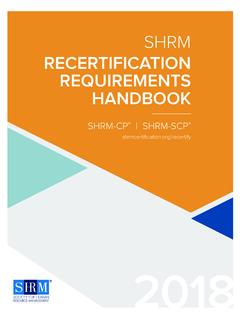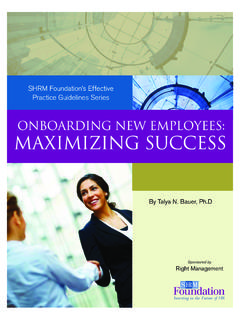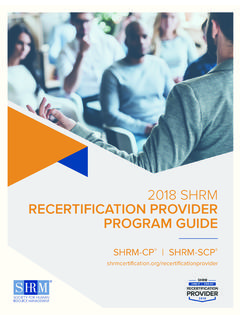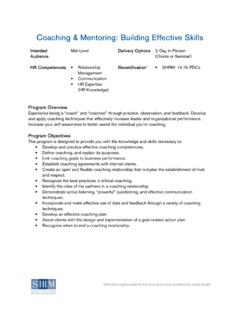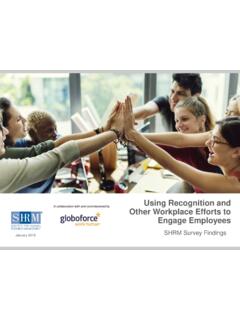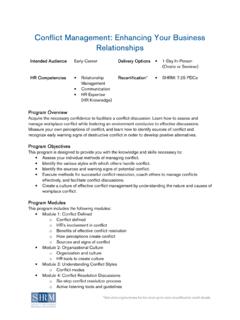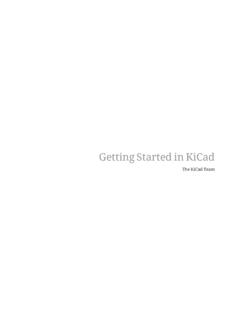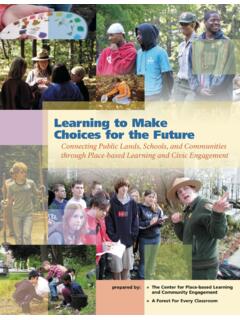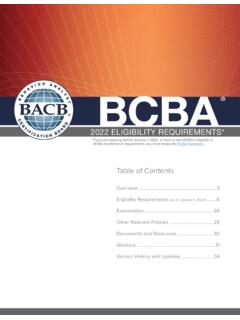Transcription of Developed by: NOVA SHRM And Dulles SHRM Updated …
1 Mentoring Program Toolkit Establishing a Mentoring Program in your Local shrm Chapter Developed by: NOVA shrm And Dulles shrm Updated April 2012 Mentoring Program Toolkit Introduction Mentoring Program Toolkit Page 2 of 72 TABLE OF CONTENTS I. getting started ..3 Introduction .. 3 Welcome to the NOVA shrm / Dulles shrm Mentoring Toolkit! .. 3 How do I use this Toolkit? .. 3 Toolkit Contributors .. 4 Mentoring Fundamentals .. 5 Overview of Mentoring: What is Mentoring? .. 5 What is a Mentor? .. 5 What are the Different Types of Mentoring? .. 5 Benefits of Mentoring .. 8 NOVA shrm / Dulles shrm s Mentoring Program Model and History .. 9 Our Mentoring Model .. 9 How Our Simple Mentoring Program Expanded Over the Years .. 10 II. Mentoring Program Process .. 13 Overview of NOVA shrm / Dulles shrm s Mentoring Program Process.
2 13 Step 1 Developing a Business Case .. 14 Step 2 Developing Program Infrastructure and Components .. 16 Step 3 Marketing, Recruiting, and Selecting Program Participants .. 19 Step 4 Conducting Program Sessions .. 21 Step 5 Evaluating, Adjusting, and Continuing the Program .. 23 III. Tools, Templates, and Additional Resources .. 24 Tools and Template Index .. 24 Find other Resources about Mentoring .. 70 Mentoring Program Toolkit Introduction Mentoring Program Toolkit Page 3 of 72 I. getting started INTRODUCTION WELCOME TO THE NOVA shrm / Dulles shrm MENTORING TOOLKIT! This Toolkit provides information, resources, and tools for implementing a mentoring program in your local shrm chapter. If you have any questions about this Toolkit or its contents, please contact Mary Kitson at or The purpose of this Toolkit is to provide guidance and tools to shrm chapters and shrm members interested in establishing mentoring programs.
3 Developing a mentoring program in your local chapter will allow you to engage chapter members, support professional development, and provide a venue for connecting human resources professionals in your local community. Individuals who are mentored have an increased likelihood of success and promotion as a result of professional networking and the targeted support they receive through developmental activities (Center for Creative Leadership, 2005). HOW DO I USE THIS TOOLKIT? The process guidance, tools, and resources in this Toolkit are based on the NOVA shrm / Dulles shrm Mentoring Program s 15 years of practices and experiences. While many of the ideas and techniques in this Toolkit should be considered best practices, the NOVA shrm / Dulles shrm Mentoring Program continuously improves and evolves the program to reflect current business trends and members needs.
4 A shrm chapter just embarking on the process of implementing a mentoring program or considering the idea of implementing a program, may want to select only a few of the mentoring program components offered in this Toolkit to implement initially. Incremental implementation of mentoring program components will allow you to evaluate the components impact and fit with your chapter before implementing additional, more comprehensive program elements. See Section: NOVA shrm / Dulles shrm s Mentoring Program Model and History, of this toolkit to learn how the NOVA shrm / Dulles shrm Mentoring Program evolved, evaluated and expanded over time. Additionally, many of the components presented in this Toolkit can be scaled and modified to fit a larger or smaller chapter. See Section: Considerations for Scaling Mentoring Program Components to Fit Your Chapter s Needs for additional tips on scaling your chapter s program.
5 This Toolkit is divided into three main sections as described below. Toolkit users are encouraged to visit all Toolkit sections for a comprehensive overview of mentoring, best practices, and tools and resources for designing and implementing a mentoring program. I. getting started Mentoring Program Toolkit Introduction. Provides an overview of the Toolkit s purpose and contents. Mentoring Fundamentals. Details the different the types of mentoring and the benefits of establishing a local mentoring program within your chapter. Mentoring Program Toolkit Introduction Mentoring Program Toolkit Page 4 of 72 The History and Model Behind NOVA shrm / Dulles shrm s Mentoring Program. Provides information about the NOVA shrm / Dulles shrm Mentoring Program model and the history behind the program. II. Establishing a Mentoring Program NOVA shrm / Dulles shrm s Mentoring Program Process.
6 Reviews NOVA shrm / Dulles shrm Mentoring Program s process for establishing and executing its current program. Where applicable, this section includes considerations and tips for tailoring program components to meet your specific chapter s needs. III. Tools, Templates, and Additional Resources Tools and Templates. Provides the templates and tools utilized by NOVA shrm / Dulles shrm Mentoring Program to execute its current mentoring program. Find Other Resources About Mentoring. Recommends additional mentoring related resources such as books, articles and websites. As mentioned above, if you have questions about this Toolkit or seek advice on how to start a mentoring program in your shrm chapter, please contact Mary Kitson, at or TOOLKIT CONTRIBUTORS This toolkit was Developed by a special project team comprised of NOVA shrm / Dulles shrm Mentoring Program alumni and NOVA and Dulles shrm chapter leaders in 2009.
7 The Mentoring Program Director, Mary Kitson, would like to recognize the project team and their affiliations: Maggie Moore, Project Lead, NOVA Chapter Mary Fetter, SPHR, NOVA Chapter Jessica Griffiths, PHR, NOVA Chapter Sharifa Gomez, CHRP, NOVA Chapter Nidhi Kanungo, PHR, Dulles Chapter Cindy Loison, SPHR, Dulles Chapter Brooke Matheson, SPHR NOVA Chapter Lindsay Muirhead, PHR, NOVA Chapter Carol Anne Snider, PHR, NOVA Chapter Chas Sumser, SPHR, Dulles Chapter This toolkit was Updated in April 2012 by Lindsay Muirhead, PHR, NOVA Chapter. Mentoring Fundamentals Mentoring Program Toolkit Page 5 of 72 MENTORING FUNDAMENTALS OVERVIEW OF MENTORING: WHAT IS MENTORING? Mentoring is a partnership between two people which supports a personal and professional development strategy. Mentoring is a term generally used to describe a relationship between a less experienced individual, called a mentee, and a more experienced individual known as a mentor.
8 Mentoring can either involve a one-on-one relationship or a network of multiple mentors. See Section: What are the Different Types of Mentoring? for more information. WHAT IS A MENTOR? A mentor is an experienced person who provides information, advice, support, and encouragement to another person, often leading and guiding by example through his/her expertise or success. In a more general sense, a good mentor is anyone you can learn something from. Mentors serve as trusted and significant advisors, providing a sounding board for day-to-day issues encountered on the job and alternative perspectives on issues in terms of both problem identification and problem solving. The table below offers attributes of effective mentors and effective mentees. Effective Mentors Effective Mentees Encourage the exploration of ideas and risk taking in learning Provide appropriate and timely advice Serve as a confident for work-related issues Help mentee to shift his/her mental context Suggest appropriate skills training Serve as a source of information and resources Be open to receiving feedback and coaching Take responsibility for your own professional growth and development Seek challenging assignments and new responsibilities Keep commitments agreed to with your mentor Renegotiate the mentoring relationship when your personal or professional needs change WHAT ARE THE DIFFERENT TYPES OF MENTORING?
9 Mentoring can take on different forms. Traditional mentoring involves a one-on-one relationship between a more experienced mentor and his/her mentee, while non-traditional mentoring can take on a variety of forms such as a network of multiple mentors, for example, peers. I think mentors are important and I don t think anybody makes it in the world without some form of mentorship. Nobody makes it alone. Nobody has made it alone. And we are all mentors to people even when we don t know it. - Oprah Winfrey Mentoring Fundamentals Mentoring Program Toolkit Page 6 of 72 Mentoring can also be characterized as either formal or informal. The most common form of mentoring is informal which is defined by a spontaneous, casual relationship where two individuals provide each other with professional guidance and counsel. Alternatively, formal mentoring is defined by a structured program designed to create a framework within which people can proactively support the development of one another.
10 In these formal programs, mentors are generally matched with mentees or peers to support specific goals such as career or leadership development. The table below provides a description of different types/models of mentoring, including more innovative types, and also the benefits of utilizing each approach. Type of Mentoring Definition Benefits Traditional One-on-One Mentoring A mentor, typically a successful and seasoned professional, works with a mentee (or prot g ), usually less experienced, to grow and advance the mentee s career and networks The focus of traditional mentoring is the overall development of the mentee The mentor shares his/her experiences and feedback with the mentee regarding technical knowledge, organizational relationships and tips for success By passing on lessons learned, the mentor has the opportunity to give back to the organization and the mentee is able to further his/her professional development Peer Mentoring A peer mentor is a mentor at a similar professional experience level, but with expertise in a subject area that his/her partner does not possess A peer mentor helps his/her partner to improve on-the-job performance, working relationships, and personal satisfaction with work An effective peer mentor listens, gathers information.
